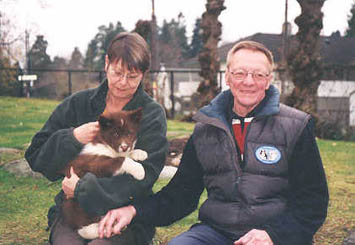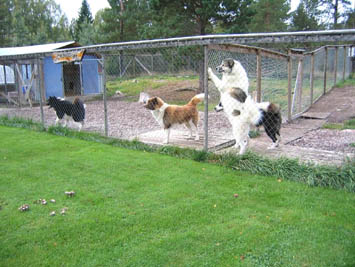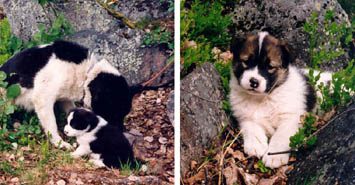Table of Contents
*
F.I.D.O.: Jan Erik and Barbro Engebretsen
*
First Camping Adventure with Greenland Dogs
*
The Breeding and Maintenance of Sledge Dogs, Part II
*
A Cut Above the Rest
*
In the News
*
Book Reviews:
Hunting Laika Breeds of Russia
Primitive Breeds - Perfect Dogs
*
IMHO: Waiting for Godot?
*
Index to Volume 6
Navigating This
Site
Index of articles by subject
Index
of back issues by volume number
Search The
Fan Hitch
Articles
to download and print
Ordering
Ken MacRury's Thesis
Our
comprehensive list of resources
Talk
to The
Fan Hitch
The Fan
Hitch home page
ISDI
home page
Editor's/Publisher's Statement
Editor: Sue Hamilton
Webmaster: Mark Hamilton
The Fan Hitch welcomes your letters, stories, comments and suggestions. The editorial staff reserves the right to edit submissions used for publication.
Contents of The Fan Hitch are protected by international copyright laws. No photo, drawing or text may be reproduced in any form without written consent. Webmasters please note: written consent is necessary before linking this site to yours! Please forward requests to Sue Hamilton, 55 Town Line Rd., Harwinton, Connecticut 06791, USA or mail@thefanhitch.org.
This site is dedicated to the Inuit Dog as well as related Inuit culture and traditions. It is also home to The Fan Hitch, Journal of the Inuit Sled Dog.

Barbo, Jan Eric and Goliat enjoying each
other's
company
Lund
photo
Jan Erik and Barbro Engebretsen
TFH: Where do you
live?
We live about twenty Scandinavian miles (each Scandinavian
mile equals
six English miles) north-east of Oslo on the Swedish side
of the border
in a very small village called Lovstaholm, with lots of
lakes and forest,
plenty of roads for training dogs. The climate is sub
arctic and arctic.
TFH: Tell us about
yourselves?
I am a Norwegian born former professional offshore and
salvage diver,
now retired. My wife Barbro comes from Gothenburg, Sweden.
We have been
married for about twenty-three years. We are members
of the Swedish
Polar Dog Club.
TFH: How long have
you owned sled
dogs?
For about ten years.
TFH: Were Inuit
Dogs the first
(or only) breed you chose?
No, because of living in a big town (Gothenburg) we bought
a German
Shepard in 1990 and after a while another one. With dogs a
new world opened.
We joined a local club for training our dogs. I also
served as instructor
for training dogs for the Swedish Air Force. On holidays
Barbro and I were
often up in the Scandinavian mountains, summer and
winter, walking
and skiing with our dogs who pulled a "pulka" (Nordic
style sled).
TFH: What was the
journey in your
life that you brought you to owning Inuit Sled Dogs,
and what attracted
you to owning Inuit Dogs?
We realized that German Shepards were very good dogs but
not well suited
to the winter season. Living in a tent for a week or two
we had to take
the dogs inside the tent to keep them warm during the
nights, when it was
colder than minus10 degrees C. About 1994 we decided to
buy our first Greenland
Inuit Dog. I had read much about the Norwegian explorers
and their dogs
so it was a very easy choice for me.
TFH: Where did you
get your Inuit
dogs and how many do you have?
We have now four male dogs. This is the maximum we have
decided to
have, as we want to treat them as family members and have
a very close
bond to each of them. Our Greenland Inuit Dogs come from
Norway, the youngest
from Kennel Qornoq's Arctic, owned by Marianne Lund, and
the three oldest
from Norsk Trekkhundklubb (NTK). NTK has for decades been
working with
sled dogs in the areas of Oslo, ambulance work in
cooperation with Red
Cross. The majority of the dogs they used were Greenland
Inuit Dogs.

Engebretsen
photo
TFH: How do you
kennel your dogs?
We have a fenced yard about 600 square meters divided in
two halves
with two dogs in each. Connected to one of the yards we
have a living section,
about 20 m2, with doghouses for each dog. We
have also a small
(30 v./160 w.) heat panel for keeping the hay-beds dry
when we have rainy
days, etc.
TFH: What do you
feed your dogs?
With kibble and modifying with extra fat and protein
according to how
hard and much they work. We also get extra meat in the
fall under the moose
hunt from friendly neighbors, as I am not a hunter.
TFH: What kinds of
harnesses and
sleds do you use?
Normally only Nome harnesses nowadays but we started with
Nordic equipment
since we were only skiing in the beginning. Recently I
bought a new sled
from Oppsal Treindustri in Oslo, recommended by Ove
Nygaard. It is "high
tech". It's a medium distance sled that suits me and the
equipment I have
for my trips. I really look forward for this winter
season.
TFH: What kind of
sledding did
you do with your dogs?
Often we train only two dogs at time. This gives each pair
opportunity
to act as leader dogs with training different commands.
This season we
will run mostly all four together. Fortunately we can
start right out from
the house into the wilderness for daytrips. Other times we
move further
north and west for longer trips, camping in a tent for a
week or so.

Barbo
Jan
Eric
Engebretsen
photo
TFH: What criteria
do you use to
select Inuit Dogs to own, to breed?
First of all it must be from a kennel with the desire to
protect the
pure Greenland Inuit Dog. Also a good look at the parents,
and their history
- genetic background as well as what they have achieved in
the front of
a sled. The dog I buy shall be curious and
eager to contact
me when I show interest in having contact.
TFH: Do you have a
special/unique
Inuit Dog you'd like to talk about?
Oh yes - my leader dog seven years old Nansen, white with
dark brown
and black spots. He is absolutely outstanding,
intelligent, and dominant
but never shows any aggressive attitude. The other dogs
have a great respect
for him. The first time we saw him was outside Oslo at a
meeting with the
NTK, when Nansen and his brother were only four-weeks old.
It was love
at first sight. Back in Gothenburg we decided to buy
Nansen. Some months
later when one of our German Shepards died we also bought
Nansen's black
and white brother whom we named Amundsen.
TFH: What is your
view of the future
of the Inuit Sled Dog?
This is not easy to answer, but my own opinion is that the
Inuit Greenland
dog will not be too common among mushers in Europe or up
here in Scandinavia.
It will exist in small numbers, but the breeders of ISD
must take more
responsibility to keep the breed pure, and that can only
be done by information
and lobbying from people who are working to preserve the
breed.
I'll hope in the future we can manage those breeders who are working seriously with ISD to go for quality and not only for making money.
And those of us who are working with ISD must be good ambassadors to show and inform other presumptive ISD buyers what this fantastic breed stands for.

"Amundsen" at 4.5 with his mother,
Xantippe, and "Nansen"
Pup pictures taken at 4.5 weeks of
age.
Engebretsen photo